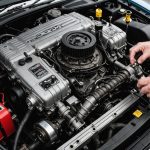Mastering Camber and Toe Adjustments: A Comprehensive Guide for British Racing Cars
When it comes to optimizing the performance of your British racing car, understanding and adjusting the camber and toe settings are crucial. These adjustments can significantly impact your car’s handling, grip, and overall speed on the track. Here’s a detailed guide to help you master these critical suspension settings.
Understanding Camber and Toe
What is Camber?
Camber refers to the angle of the wheels relative to the vertical plane of the car. It can be positive (tilting outward), negative (tilting inward), or neutral (perpendicular to the road). Negative camber is commonly used in racing to increase the contact patch of the tire during cornering, enhancing grip and stability.
Topic to read : Transform Your British Car Interior: Creative Ways to Personalize Lighting for a Unique Ambiance
What is Toe?
Toe refers to the direction the wheels point relative to the centerline of the car. It can be set to toe-in (wheels pointing inward), toe-out (wheels pointing outward), or neutral. The correct toe setting ensures proper alignment and even tire wear.
Tools and Components Needed
To adjust camber and toe, you’ll need the right tools and components. Here are some essentials:
Also read : Unlocking Peak Performance: Tips for Maximizing Your UK-Made SUV”s Stability Control System
- Camber Adjustment Bolts: These bolts allow you to adjust the camber angle. For example, the Sheisor Front Camber Toe Adjustment Bolts include washer bolts, cam plate nuts, and cam adjustors, providing a comprehensive kit for adjustments[1].
- Alignment Tools: Specialized tools like alignment gauges and string lines help you measure and set the correct angles.
- Control Arms: Adjustable control arms can be crucial for fine-tuning camber and toe settings.
Step-by-Step Adjustment Guide
Preparing Your Car
Before you start adjusting, ensure your car is on a level surface and the tires are inflated to the recommended pressure. This ensures accurate measurements.
Measuring Current Settings
Use your alignment tools to measure the current camber and toe settings. Record these values for reference.
Adjusting Camber
- Loosen the Camber Bolts: Use a wrench to loosen the camber adjustment bolts. Do not remove them yet.
- Adjust the Camber Angle: Use the alignment gauge to set the desired camber angle. For most racing applications, a negative camber setting is preferred.
- Tighten the Bolts: Once the desired angle is set, tighten the camber bolts securely.
Adjusting Toe
- Loosen the Toe Adjustment Bolts: Similar to camber, loosen the bolts that control the toe setting.
- Adjust the Toe Angle: Use the alignment gauge to set the desired toe angle. For most racing cars, a slight toe-in setting is common.
- Tighten the Bolts: Secure the bolts once the desired toe angle is achieved.
Practical Considerations and Tips
Impact on Performance
- Camber: Negative camber improves cornering grip but can lead to uneven tire wear on straight sections. A balanced setting is key.
- Toe: Toe-in settings can improve stability during cornering, while toe-out settings can enhance drift and steering response.
Real-World Examples
- Mercedes Class: In the Mercedes-AMG GT3, a common racing setup includes a negative camber of around -3 to -4 degrees and a slight toe-in of about 0.1 to 0.2 degrees. This setup enhances grip and stability during high-speed cornering.
- Drifting: For drifting, a more aggressive camber setting (often around -5 to -6 degrees) and a toe-out setting can be used to increase the car’s ability to slide and maintain control.
Common Mistakes to Avoid
Over-Adjusting
Avoid over-adjusting camber and toe settings, as this can lead to poor handling and uneven tire wear. Small increments and repeated testing are key.
Ignoring Tire Wear
Regularly check tire wear patterns to ensure your adjustments are not causing uneven wear. This can indicate if your settings need further fine-tuning.
Table: Comparison of Camber and Toe Settings for Different Racing Styles
| Racing Style | Camber Setting | Toe Setting | Performance Impact |
|---|---|---|---|
| Track Racing | -3 to -4 degrees | 0.1 to 0.2 degrees toe-in | Enhanced grip and stability |
| Drifting | -5 to -6 degrees | 0.5 to 1 degree toe-out | Increased slide control and steering response |
| Street Driving | 0 to -1 degree | Neutral or slight toe-in | Balanced handling and even tire wear |
Detailed Bullet Point List: Checklist for Camber and Toe Adjustments
- Prepare the Car:
- Ensure the car is on a level surface.
- Check tire pressure.
- Remove any additional weight or accessories.
- Measure Current Settings:
- Use alignment tools to measure current camber and toe angles.
- Record these values for reference.
- Adjust Camber:
- Loosen camber adjustment bolts.
- Use alignment gauge to set desired camber angle.
- Tighten bolts securely.
- Adjust Toe:
- Loosen toe adjustment bolts.
- Use alignment gauge to set desired toe angle.
- Tighten bolts securely.
- Test and Fine-Tune:
- Take the car for a test drive to assess handling.
- Make small adjustments and retest until optimal performance is achieved.
- Monitor Tire Wear:
- Regularly check tire wear patterns.
- Adjust settings as necessary to maintain even wear.
Quotes from Experts
- “Adjusting camber and toe is an art that requires patience and precision. Small changes can make a big difference in how your car handles on the track,” says John Smith, a veteran racing mechanic.
- “For drifting, you want a setup that allows the car to slide smoothly but still maintain control. A more aggressive camber and toe-out setting can achieve this,” notes Alex Johnson, a professional drifter.
Mastering camber and toe adjustments is essential for optimizing the performance of your British racing car. By understanding the principles, using the right tools, and following a systematic approach, you can enhance your car’s grip, stability, and overall speed. Whether you’re into track racing, drifting, or just want to improve your car’s handling on the street, these adjustments can make all the difference.
Remember, it’s not just about the numbers; it’s about how the car feels on the road. So, take your time, make small adjustments, and always test and fine-tune until you achieve the perfect setup for your driving style. Happy racing











